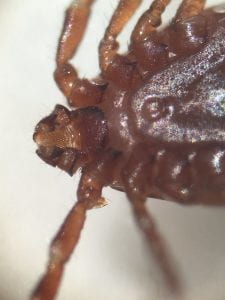
Looking for information on that tick that recently killed 5 cows in North Carolina? The Asian Longhorned Tick is also in NY and may threaten our dairy and livestock industries. Thanks to NYSIPM’s Field Crops and Livestock team, we welcome you to visit our new page to learn more about this serious pest and learn where you can get livestock ticks identified.
As much as we enjoy doing what we do at the NYS Integrated Pest Management Program, there are already plenty of pests to go around. Unfortunately, here’s our newest one found on our INVASIVES page: ASIAN LONGHORNED TICK. Haemaphysalis longicornis; ALT.
**Look for the NYS IPM booth at Empire Farm Days for more information or conversation about this tick and how it may affect your farm.
ALT is a special concern to livestock farmers!
Note: If you’re looking for long horns on this tick’s head, you’ll be disappointed. The common name is thought to come from either the spiky points on the tick’s scutum (aka shoulders), or from the points on the side of the head.
Acronyms abound in all parts of our lives. In our ‘business’, common names can be strikingly similar (Spotted Wing Drosophila, SWD, or Spotted Lanternfly, SLF) (Asian Longhorned Tick, Asian Longhorned Beetle) (Black-legged Tick, BLT, Longhorned Tick, ALT, Lone Star Tick, LST). Hopefully by now you know IPM as Integrated Pest Management.
Biology
- One parthenogenic female (reproduces without males) can produce hundreds or thousands of offspring
- Cold temperature tolerance creates potential for establishment in the northeast
- Broad host range – but prefers cattle
- Attaching to birds and wildlife allow ALT to spread quickly over an increasing area
- Preferred habitat: pastures, meadows

Distribution
- Native to Eastern Asia, invasive ALT became the highly problematic ‘cattle tick’ on Australia and New Zealand livestock
- Since the 2017 discovery in New Jersey, it’s now in New York and many Northeastern states

Impact: ALT damages livestock health and impairs milk production
- Severe infestation causes anemia or death from blood loss
- ALT feeding can transmit bovine theileriosis and parasites that cause babesiosis
- Theileriosis can significantly reduce milk production and kill calves

Management
- Monitor livestock regularly for ticks – collect and submit suspicious ticks for identification
- Typical tick insecticide treatments—ear tags, sprays, dips, pour-ons and powders—are effective against ALT

IPM for livestock ticks
- Inspect animals regularly for ticks
- When indicated, use timely application of insecticides
- Minimize tick habitat in pasture and feedlots by keeping grasses and weeds trimmed
- Pasture rotation
- Deer exclusion limits re-introduction of ticks from wildlife
- Chickens and guinea fowl in pastures eat adult ticks, but typically not nymphs
- Opossums eat vast amounts of ticks
Consider following our WEBSITE, THINK IPM BLOG, FACEBOOK PAGE, FLICKR, or TWITTER to access all the latest news not only on this invasive pest but all our activities:
IPM is as broad as our selection of photos. On farms, vineyards, orchards; in schools, nursing homes, playgrounds; in your own home, lawn, or garden—IPM is foundational to sound, careful, economical ways of dealing with pests.
Our Mission: The New York State Integrated Pest Management Program develops sustainable ways to manage pests and helps people to use methods that minimize environmental, health, and economic risks.
